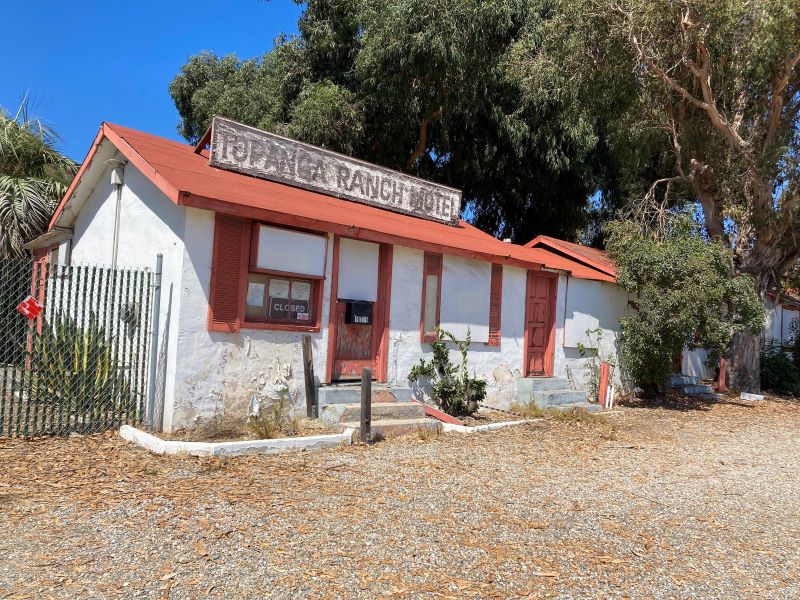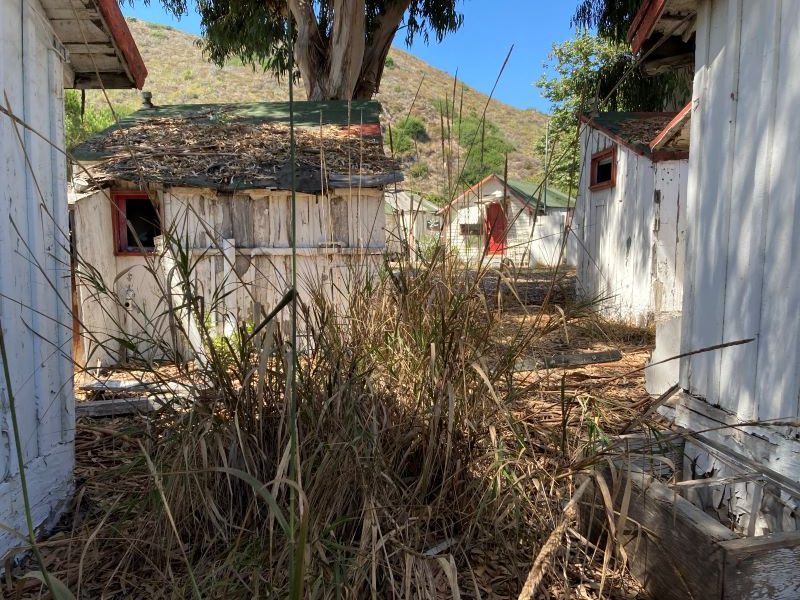
The historic Topanga Ranch Motel has won a reprieve. When the Topanga Lagoon Restoration Project moves forward, the motel will be restored, instead of demolished, and will eventually reopen.
This small rustic row of cabins is one of the last surviving examples of an early bungalow-style motel. It began life as a campground run by Miller Cooper and called Cooper’s Camp in 1919. The cabins were added in 1920 to house a classical musicians’ summer camp. In 1923, the highway was built through part of the Camp. Miller Cooper gave up the business in 1926, and the Camp was renamed the Topanga Beach Auto Court in 1928. The motel had to be moved dozens of feet inland when the highway was straightened in 1933. Behind the motel, on Topanga Lane, William Spence operated a separate motel called Spence’s Cabins from about 1930 until 1953.
Topanga Historical Society archivist Pablo Capra recounts the early history of the motel in a 2020 feature in the Messenger Mountain News. He writes that Spence moved into one of the first summer beach rentals at Topanga Beach after medical and financial problems necessitated a change of lifestyle and career. Spence and his family vacationed there in the early 1920s. The small house became the Spences’ permanent home in the late 1920s.
“William created a motel business called Spence’s Cabins by taking over the house next door, subdividing it into six units, and building an arched sign that joined the properties,” Capra writes.
The current motel appears to have been configured in 1933, when an application was filed to “Alter [an] Auto Camp, [at] Roosevelt Highway and Topanga Canyon,” according to a 2019 report on the condition of the cabins for State Parks. The report adds that, “the site operator is believed to have repurposed many of the former wood-framed cabins that were originally at the site prior to 1933.”
The motel remained open and largely unchanged for decades. It provided an inexpensive seaside holiday spot for families, a quiet retreat for writers, a rendez-vous for romantic assignations, a film and television location, and a favorite subject for photographers.
In the 1980s, a plan to channelize the creek—to “safely and permanently route it to the sea”, the LA Times reported—bulldoze the motel, and build a mini city with as many as eight-hundred condos and apartments and a retail center with shops, became part of the fight over cityhood in Malibu. The plan was defeated and the motel remained open, although over time it became ramshackle and decrepit.
When State Parks acquired the site in 2001, many preservationists cherished the hope that the motel would be restored. Instead, it closed in 2004, and didn’t reopen. Hopes rose again last decade, when a new Coastal Commission program began to assess “in lieu” funding to provide affordable beach accommodations and mitigate the loss of public benefit at other development projects.
In lieu money earmarked for the Topanga Rancho Motel poured in. In 2019, the owners of a posh Santa Monica hotel were assessed a $15.5 million fine when they failed to include the affordable accommodations they promised. Much of that money was supposed to be for the restoration of the Topanga Ranch Motel, but nothing happened. The cabins continued to weather and decay. White paint peeling, red trim fading to dusty brown.
When the Topanga Lagoon Restoration Project was first introduced, hope for the old motel was revived. One of the proposed project options would have completely demolished the buildings, but there was also support for saving and restoring the cabins.
The preferred alternative for the restoration project was released last month. It contains a reprieve for the old motel. As many as 20 of the cabins will be retained, restored, and reopened. Why 20 or less? Several of the 32 cabins were too close to the creek and have been damaged or even destroyed by floods, some are too decayed or unsafe to be restored, but a number of cabins have been used by park personnel and are in relatively good repair, and others still have the potential to be rebuilt.

State Park’s decision to retain and restore the motel is good news for history buffs, but it is also an important public benefit. Affordable beach accommodations have become increasingly scarce. A functioning Topanga Ranch Motel is almost guaranteed to be as popular as another State Park accommodation: Crystal Cove Beach Cottages in Orange County. That site, comprising 46 vintage rustic coastal cottages—21 available to the public—is so popular that reservations fill up the second they are available.
For now, the old Topanga Ranch Motel is still shuttered, quietly decaying, but there may still be life in this historic relic, perhaps even another hundred years of Topanga beach vacation memories.





This article title aged like milk.
Here’s a fun theme song to go with the article.
https://youtu.be/c0csHgHwTC8?si=65zRnamFpq2V_NI1
I know the structures might be burnt down, but the signs still there. I say we rebuild it.!!
I’ll chip in!!!
[…] according to the state’s parks department. It had been unkempt over the past few decades, but plans were recently put in place to restore roughly 20 cabins for public […]
[…] according to the state’s parks department. It had been unkempt over the past few decades, but plans were recently put in place to restore roughly 20 cabins for public […]
[…] and also served as a retreat for families and filmmakers, the parks agency said. The motel was long shuttered, but “plans had been in the works to restore about 20 of the cabins for public use,” the parks […]
[…] and also served as a retreat for families and filmmakers, the parks agency said. The motel was long shuttered, but “plans had been in the works to restore about 20 of the cabins for public use,” the parks […]
[…] and also served as a retreat for families and filmmakers, the parks agency said. The motel was long shuttered, but “plans had been in the works to restore about 20 of the cabins for public use,” the parks […]
[…] and also served as a retreat for families and filmmakers, the parks agency said. The motel was long shuttered, but “plans had been in the works to restore about 20 of the cabins for public use,” the parks […]
[…] and also served as a retreat for families and filmmakers, the parks agency said. The motel was long shuttered, but “plans had been in the works to restore about 20 of the cabins for public use,” the parks […]
[…] and also served as a retreat for families and filmmakers, the parks agency said. The motel was long shuttered, but “plans had been in the works to restore about 20 of the cabins for public use,” the parks […]
[…] served as a retreat for families and filmmakers, the parks agency said. The motel was long shuttered, but “plans had been in the works to restore about 20 of the cabins for public use,” the parks […]
[…] y también sirvió de refugio a familias y cineastas, según la agencia de parques. El motel fue cerrado hace mucho tiempo, pero “había planes para restaurar alrededor de 20 de las cabañas para uso […]
[…] sirvió de refugio a familias y cineastas, según la agencia de parques. El motel fue cerrado hace mucho tiempo, pero “había planes para restaurar alrededor de 20 de las […]
[…] y también sirvió de refugio a familias y cineastas, según la agencia de parques. El motel fue cerrado hace mucho tiempo, pero “había planes para restaurar alrededor de 20 de las cabañas para uso […]
[…] and also served as a retreat for families and filmmakers, the parks agency said. The motel was long shuttered, but “plans had been in the works to restore about 20 of the cabins for public use,” the parks […]
[…] y también sirvió de refugio a familias y cineastas, según la agencia de parques. El motel fue cerrado hace mucho tiempo, pero “había planes para restaurar alrededor de 20 de las cabañas para uso […]
[…] actor’s ranch house. And blazes that swept through Topanga State Park destroyed the iconic Topanga Ranch Motel—once owned by 20th-century newspaper publisher William Randolph Hearst. State park employee […]
[…] in Malibu, was one of the last surviving examples of an early bungalow-style motel in California, according to Topanga Historical Society archivist Pablo […]